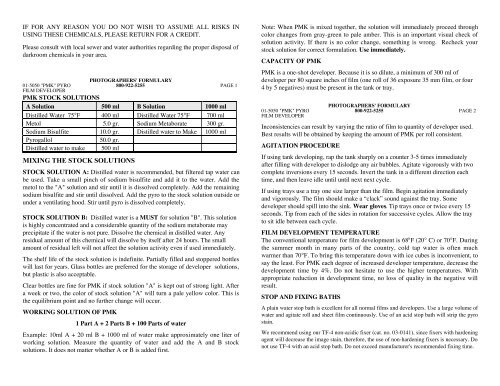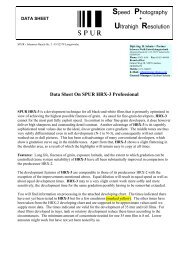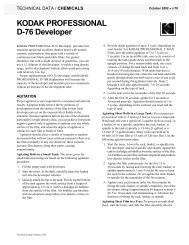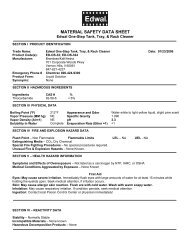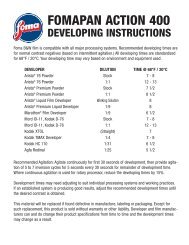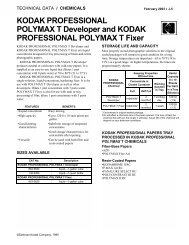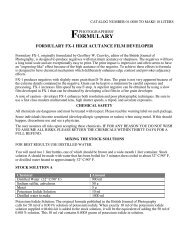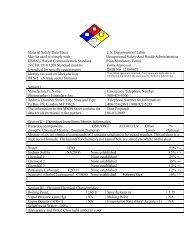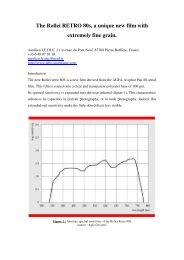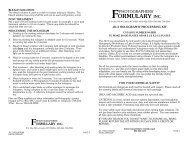Instructions & Technical Data (pdf)
Instructions & Technical Data (pdf)
Instructions & Technical Data (pdf)
You also want an ePaper? Increase the reach of your titles
YUMPU automatically turns print PDFs into web optimized ePapers that Google loves.
IF FOR ANY REASON YOU DO NOT WISH TO ASSUME ALL RISKS IN<br />
USING THESE CHEMICALS, PLEASE RETURN FOR A CREDIT.<br />
Please consult with local sewer and water authorities regarding the proper disposal of<br />
darkroom chemicals in your area.<br />
01-5050 "PMK" PYRO<br />
FILM DEVELOPER<br />
PHOTOGRAPHERS' FORMULARY<br />
800-922-5255 PAGE 1<br />
PMK STOCK SOLUTIONS<br />
A Solution 500 ml B Solution 1000 ml<br />
Distilled Water 75°F 400 ml Distilled Water 75°F 700 ml<br />
Metol 5.0 gr. Sodium Metaborate 300 gr.<br />
Sodium Bisulfite 10.0 gr. Distilled water to Make 1000 ml<br />
Pyrogallol<br />
50.0 gr.<br />
Distilled water to make 500 ml<br />
MIXING THE STOCK SOLUTIONS<br />
STOCK SOLUTION A: Distilled water is recommended, but filtered tap water can<br />
be used. Take a small pinch of sodium bisulfite and add it to the water. Add the<br />
metol to the "A" solution and stir until it is dissolved completely. Add the remaining<br />
sodium bisulfite and stir until dissolved. Add the pyro to the stock solution outside or<br />
under a ventilating hood. Stir until pyro is dissolved completely.<br />
STOCK SOLUTION B: Distilled water is a MUST for solution "B". This solution<br />
is highly concentrated and a considerable quantity of the sodium metaborate may<br />
precipitate if the water is not pure. Dissolve the chemical in distilled water. Any<br />
residual amount of this chemical will dissolve by itself after 24 hours. The small<br />
amount of residual left will not affect the solution activity even if used immediately.<br />
The shelf life of the stock solution is indefinite. Partially filled and stoppered bottles<br />
will last for years. Glass bottles are preferred for the storage of developer solutions,<br />
but plastic is also acceptable.<br />
Clear bottles are fine for PMK if stock solution "A" is kept out of strong light. After<br />
a week or two, the color of stock solution "A" will turn a pale yellow color. This is<br />
the equilibrium point and no further change will occur.<br />
WORKING SOLUTION OF PMK<br />
1 Part A + 2 Parts B + 100 Parts of water<br />
Example: 10ml A + 20 ml B + 1000 ml of water make approximately one liter of<br />
working solution. Measure the quantity of water and add the A and B stock<br />
solutions. It does not matter whether A or B is added first.<br />
Note: When PMK is mixed together, the solution will immediately proceed through<br />
color changes from gray-green to pale amber. This is an important visual check of<br />
solution activity. If there is no color change, something is wrong. Recheck your<br />
stock solution for correct formulation. Use immediately.<br />
CAPACITY OF PMK<br />
PMK is a one-shot developer. Because it is so dilute, a minimum of 300 ml of<br />
developer per 80 square inches of film (one roll of 36 exposure 35 mm film, or four<br />
4 by 5 negatives) must be present in the tank or tray.<br />
01-5050 "PMK" PYRO<br />
FILM DEVELOPER<br />
PHOTOGRAPHERS' FORMULARY<br />
800-922-5255 PAGE 2<br />
Inconsistencies can result by varying the ratio of film to quantity of developer used.<br />
Best results will be obtained by keeping the amount of PMK per roll consistent.<br />
AGITATION PROCEDURE<br />
If using tank developing, rap the tank sharply on a counter 3-5 times immediately<br />
after filling with developer to dislodge any air bubbles. Agitate vigorously with two<br />
complete inversions every 15 seconds. Invert the tank in a different direction each<br />
time, and then leave idle until until next next cycle.<br />
If using trays use a tray one size larger than the film. Begin agitation immediately<br />
and vigorously. The film should make a “clack” sound against the tray. Some<br />
developer should spill into the sink. Wear gloves. Tip trays once or twice every 15<br />
seconds. Tip from each of the sides in rotation for successive cycles. Allow the tray<br />
to sit idle between each cycle.<br />
FILM DEVELOPMENT TEMPERATURE<br />
The conventional temperature for film development is 68°F (20° C) or 70°F. During<br />
the summer month in many parts of the country, cold tap water is often much<br />
warmer than 70°F. To bring this temperature down with ice cubes is inconvenient, to<br />
say the least. For PMK each degree of increased developer temperature, decrease the<br />
development time by 4%. Do not hesitate to use the higher temperatures. With<br />
appropriate reduction in development time, no loss of quality in the negative will<br />
result.<br />
STOP AND FIXING BATHS<br />
A plain water stop bath is excellent for all normal films and developers. Use a large volume of<br />
water and agitate roll and sheet film continuously. Use of an acid stop bath will strip the pyro<br />
stain.<br />
We recommend using our TF-4 non-acidic fixer (cat. no. 03-0141), since fixers with hardening<br />
agent will decrease the image stain, therefore, the use of non-hardening fixers is necessary. Do<br />
not use TF-4 with an acid stop bath. Do not exceed manufacturer's recommended fixing time.


